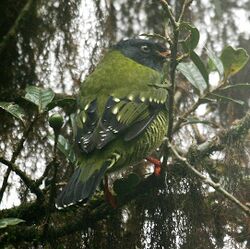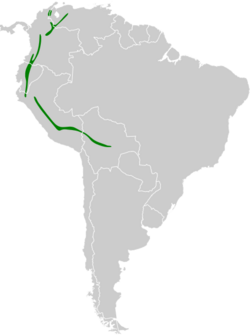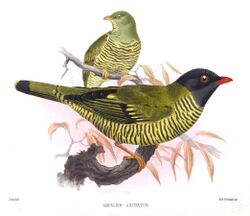Biology:Barred fruiteater
| Barred fruiteater | |
|---|---|

| |
| File:Pipreola arcuata - Barred Fruiteater XC248404.mp3 | |
| Scientific classification | |
| Domain: | Eukaryota |
| Kingdom: | Animalia |
| Phylum: | Chordata |
| Class: | Aves |
| Order: | Passeriformes |
| Family: | Cotingidae |
| Genus: | Pipreola |
| Species: | P. arcuata
|
| Binomial name | |
| Pipreola arcuata (Lafresnaye, 1843)
| |

| |
The barred fruiteater (Pipreola arcuata) is a species of bird in the family Cotingidae, found in Bolivia, Colombia, Ecuador, Peru, and Venezuela. Its natural habitat is subtropical or tropical moist montane forests. The population is stable, and they are considered common.[2]
Description
This bird is the largest of the fruiteaters and the only one with barred underparts in both sexes. It is a dumpy, rather sluggish bird, growing to a length of 23 cm (9 in). The male has a glossy black head and throat, and the remainder of the upper parts is greenish-brown. The tail is tipped with black and the wings have large areas of yellowish spotting. The underparts are finely barred in black and pale yellow. The head, throat and upper parts of the female are entirely greenish-brown and the underparts are similar to those of the male. Birds at the northern end of the range have orange-red irises while those at the southern end are pale grey or olive. The legs and beak are orange-red. The song is a faint, high-pitched "seeeeeeeh".[3]
Distribution
The barred fruiteater is native to mountainous parts of South America. Its range extends from Venezuela, Colombia and Ecuador to Peru and Bolivia and its altitudinal range is from 2,250 to 3,300 metres (7,400 to 10,800 ft), going higher than any other fruiteater.[3] It usually moves through the forest singly or in pairs, but at particularly fruitful trees, several birds may congregate.[3]
Status
Pipreola arcuata has a very wide range and is common over much of that area. The total area of occupancy is about 259,000 square kilometres (100,000 sq mi).[2] Its population seems to be steady, and the International Union for Conservation of Nature has assessed its conservation status as being of "least concern".[1]
References
- ↑ 1.0 1.1 BirdLife International (2016). "Pipreola arcuata". IUCN Red List of Threatened Species 2016: e.T22700788A93796596. doi:10.2305/IUCN.UK.2016-3.RLTS.T22700788A93796596.en. https://www.iucnredlist.org/species/22700788/93796596. Retrieved 17 November 2021.
- ↑ 2.0 2.1 Species factsheet: Barred fruiteater Pipreola arcuata BirdLife International.
- ↑ 3.0 3.1 3.2 Ridgely, Robert S.; Tudor, Guy (2009). Field Guide to the Songbirds of South America: The Passerines. University of Texas Press. p. 504. ISBN 978-0-292-71748-0. https://books.google.com/books?id=gC_A2fpBl1gC&pg=PA305.
Wikidata ☰ Q976993 entry
 |



